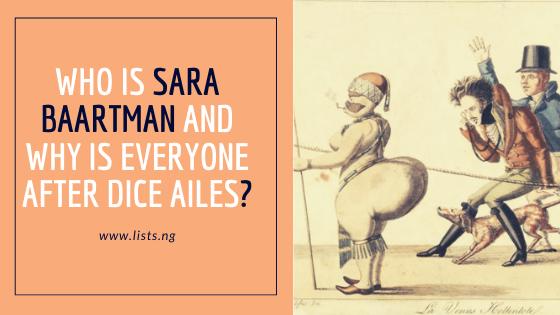Chocolate City’s singer Dice Ailes has been faced with a huge backlash following his use of a picture of Sara Baartman on the artwork of his latest single. This has been labeled insensitive and ignorant due to the inhumane discrimination and humiliation that Sara Baartman suffered for the most part of her life and even after her death, as well as what she now stands for.

Birth and early life
Sara Baartman, called “Saartjie” was born in the 1770s likely in the Camdeboo valley in the eastern part of the Cape Colony to a Khoikhoi family. Sara Baartman spent her childhood and teenage years on settler farms but as she grew older, she lived in Cape Town for at least two years working in households as a washerwoman and a nursemaid, first for Peter Cesars, then in the house of a Dutch man in Cape Town. She finally moved to be a wet-nurse in the household of Peter Cesars’s brother, Hendrik Cesars, outside of Cape Town in present day Woodstock.
Contact with William Dunlop and exhibitions in England and Ireland
While working as a wet-nurse in the household of Peter Cesars’s brother, Hendrik Cesars, outside of Cape Town, William Dunlop, a Scottish military surgeon in the Cape slave lodge, with a sideline in supplying showmen in Britain with animal specimens, suggested she travel to England to make money by exhibiting herself. Baartman refused and said she would only go if Hendrik Cesars came too. Hendrik himself refused, but as he became ever more indebted, he finally agreed in 1810 to go to England to make money by putting Baartman on stage.
In London, Dunlop exhibited Baartman in the Egyptian Hall of Piccadilly Circus on 24 November 1810. People came to see her because they saw her not as a person but as a pure example of this one part of the natural world.
Attempts to rescue her
While in England, an abolitionist benevolent society called the African Association conducted a newspaper campaign for her release. However, Hendrik Cesars claimed that Sara Baartman was entitled to earn her living, stating. The African Association eventually took the matter to court and on 24 November 1810 at the Court of King’s Bench the Attorney-General began the attempt “to give her liberty to say whether she was exhibited by her own consent.”
However the case was never a winnable one especially because the court saw Hendrik Cesars as the boer exploiter, rather than seeing Dunlop as the organizer. Thus, during Sara Baartman’s testimony, they ensured that Cesars was not in the room when Baartman made her statement, but Dunlop was allowed to remain. The court claimed she stated that she was never under restraint, did not get sexually abused, that she was never forced to come to England and that she also did not wish to return to her family. This statement was deemed as false according to accounts of her exhibitions made by the African Institution and other eyewitnesses. The statement eventually led to the case being dismissed.
The publicity given by the court case increased Baartman’s popularity as an exhibit She later toured other parts of England and was exhibited at a fair in Limerick, Ireland in 1812. She also was exhibited at a fair at Bury St Edmunds in Suffolk.
Exhibitions in France
In September 1814, a man called Henry Taylor took Sara Baartman to France. Taylor then sold her to an animal trainer, S. Réaux, who exhibited her under more pressured conditions for 15 months at the Palais Royal. In France she was in effect enslaved. In Paris, her exhibition became more clearly entangled with scientific racism.
Death
Sara Baartman died on 29 December 1815 aged 26, of an undetermined inflammatory ailment, possibly smallpox, while other sources suggest she contracted syphilis, or pneumonia.
No rest even in death
Even after her death, Sara Baartman wasn’t allowed to rest in peace. Geoffroy Saint Hilaire applied on behalf of the Muséum d’ Histoire Naturelle to retain her corpse on the grounds that it was of singular specimen of humanity and therefore of special scientific interest. The application was approved and her skeleton and body cast were displayed in Muséum d’histoire naturelle d’Angers. In 1827, her skull was stolen but later returned a few months later.
Her restored skeleton and skull continued to arouse the interest of visitors until the remains were moved to the Musée de l’Homme in 1937. Her body cast and skeleton stood side by side and faced away from the viewer which emphasized her steatopygia (accumulation of fat on the buttocks) while reinforcing that aspect as the primary interest of her body. The Baartman exhibit proved popular until it elicited complaints for being a degrading representation of women. The skeleton was removed in 1974, and the body cast in 1976.
Return to South Africa
After the victory of the African National Congress in the South African general election, 1994, President Nelson Mandela formally requested that France return the remains. After much legal wrangling and debates in the French National Assembly, France acceded to the request on 6 March 2002. Sara Baartman’s remains were repatriated to her homeland, the Gamtoos Valley, on 6 May 2002, and they were buried on 9 August 2002 on Vergaderingskop, a hill in the town of Hankey over 200 years after her birth.
Legacy
Baartman became an icon in South Africa as representative of many aspects of the nation’s history. The Saartjie Baartman Centre for Women and Children, a refuge for survivors of domestic violence, opened in Cape Town in 1999. South Africa’s first offshore environmental protection vessel, the Sarah Baartman, is also named after her. On December 8th, 2018, the University of Cape Town made the historic decision to rename Memorial Hall, at the centre of the campus, to Sarah Baartman Hall.
Dice Ailes and Chocolate made an inexcusable blunder
Sara Bartmaan suffered unimaginable humiliation being used as a freek show for years. She was brought to the West solely on the premise of her elaborate female form, and the European public gained a sickening obsession with her reproductive organs. Her body parts were on display at the Musée de l’Homme for 150 years. Dice Ailes and his Chocolate City label should have conducted research before ignorantly objectifying Sara Baartman again after she had finally been laid to rest



